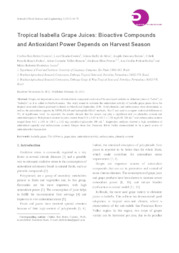Tropical Isabella grape juices: bioactive compounds and antioxidant power depends on harvest season.
Tropical Isabella grape juices: bioactive compounds and antioxidant power depends on harvest season.
Author(s): CAZARIN, C. B. B.; CORREA, L. C.; SILVA, J. K. da; BATISTA, A. G.; FURLAN, C. P. B.; BIASOTO, A. C. T.; PEREIRA, G. E.; RYBKA, A. C. P.; MARÓSTICA JUNIOR, M. R.
Summary: Grapes are important sources of antioxidants compounds and one of the most used varieties to elaborate juices is 'Isabel', or 'Isabella', as it is called in North-America. This study aimed to evaluate the antioxidant activity of Isabella grape juices from the tropical semi-arid climate produced in Brazil on March and September, 2010. Total phenolics and anthocyanins were determined, as well as the antioxidant capacity by DPPH, FRAP and hydrophilic ORAC methods. Test T was used to compare statistical difference at 5% of significance level. As expected, the results showed that the season can play a significant role on phenolics content and antioxidant power. Polyphenols content in juices varied from 82.9 ± 0.92 to 102.2 ± 1.59 mg GAE 100 mL-1 and anthocyanins content ranged from 44.3 ± 2.01 to 129.5 ± 2.82 mg cyanidin-3-glucoside 100 mL-1. Regression analyses showed a high correlation of antioxidant capacity and anthocyanins content. Grapes from Sao Francisco River Valley demonstrated to be a good source of antioxidant for human diet.
Publication year: 2013
Types of publication: Journal article
Unit: Embrapa Semi-arid Region
Keywords: Antocianina, Análise química, Atividade antioxidante, Composto Fenólico, Grape, Isabel, Nutrição, Suco, Uva, Viticultura, Vitis Vinifera
Observation
Some of Embrapa's publications are published as ePub files. To read them, use or download one of the following free software options to your computer or mobile device. Android: Google Play Books; IOS: iBooks; Windows and Linux: Calibre.
Access other publications
Access the Agricultural Research Database (BDPA) to consult Embrapa's full library collection and records.
Visit Embrapa Bookstore to purchase books and other publications sold by Embrapa.

